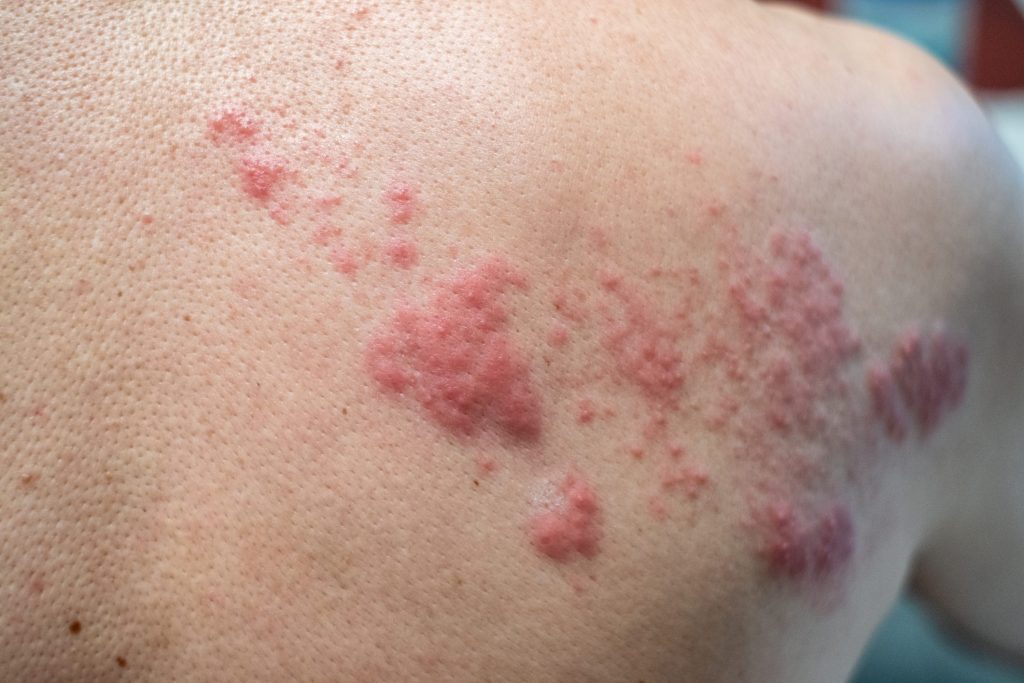- A woman nearly died of a flesh-eating skin infection that she contracted while ill with shingles.
- Her diabetes and shingles rash both put her at high risk for coinfection with more dangerous bacteria.
- The infection destroyed layers of the patient's upper back tissue, which required extensive skin grafting.
A woman survived a rare flesh-eating infection that destroyed a massive chunk of tissue on her back, according to a case report by doctors at Balıkesir University Hospital in Turkey.
The 59-year-old woman was admitted to the hospital's emergency department with a painful, necrotizing rash that covered most of her upper back. What started as a blistering case of shingles had escalated into something much more serious.
Shingles (herpes zoster) is a common reactivation of the chickenpox virus that causes a tingling or itchy rash, usually on one side of the face or torso, according to the US Centers for Disease Control and Prevention. Anyone who has had chickenpox may develop shingles, especially as they get older.
The patient in Turkey was obese and had diabetes, which can increase a person's risk of severe or long-lasting shingles, according to a 2020 review in Diabetes Research and Clinical Practice.
Her doctors noted that her rash extended across the midline of her back — a feature rarely seen in shingles cases. Bilateral shingles may indicate that another infection is present, so the woman was prescribed antibiotics as well as acyclovir, a drug used to treat shingles.
However, her rash only got worse in the weeks that followed. She was feverish and showed signs of severe infection when she was hospitalized, despite 20 days of treatment and several doctors' visits.
Upon admission, her rash was swollen and hard to the touch, with spots of visibly decaying flesh. Doctors diagnosed the woman with necrotizing fasciitis, or flesh-eating bacteria, and quickly brought her to the operating room to begin removing the dead skin and tissue.
The infection ate through her skin and into her muscle
In surgery, the doctors discovered a pocket of infection that extended under the patient's back muscle. The area around the abscess had decayed and needed to be removed.
The team debrided layers of dead and dying skin, fat, and muscle. Lab testing confirmed the presence of Streptococcus pyogenes, which causes necrotizing fasciitis among other life-threatening infections.
After the procedure was done, the woman had a significant amount of tissue missing from her upper back, extending from her left armpit to her right shoulder blade.
She was monitored in intensive care for 48 hours and was given carbapenem, a powerful antibiotic reserved for severe bacterial infections. She required a second round of debridement before her condition began to improve.
She was approved for reconstructive surgery after 18 days of hospitalization, but preparing her back for skin grafting was a lengthy process. According to photos included in the case report, the affected area was repaired with skin grafts six months after her initial discharge from the hospital.
Other complications of shingles may include long-term nerve damage
Only five cases of necrotizing fasciitis as a complication of shingles have been reported in medical literature, although additional cases have occurred with chickenpox, according to the case report. Two shingles patients died of the coinfection, but the Turkish patient survived.
Immunocompromising conditions such as diabetes can increase a person's likelihood of contracting a flesh-eating infection, according to the CDC. Scratching at a rash also ups the chance of additional bacteria getting under the skin.
More common complications of shingles include long-term nerve pain, or postherpetic neuralgia. The CDC says about 10 to 18% of people who get shingles will experience nerve pain, which may persist even after the rash has healed.
Nerve damage associated with shingles can also lead to temporary or permanent paralysis of affected muscles, as Justin Bieber recently learned. The singer had to cancel some of his tour dates as he recovered from Ramsay-Hunt syndrome, a rare complication of shingles that may cause facial paralysis and bouts of dizziness.

